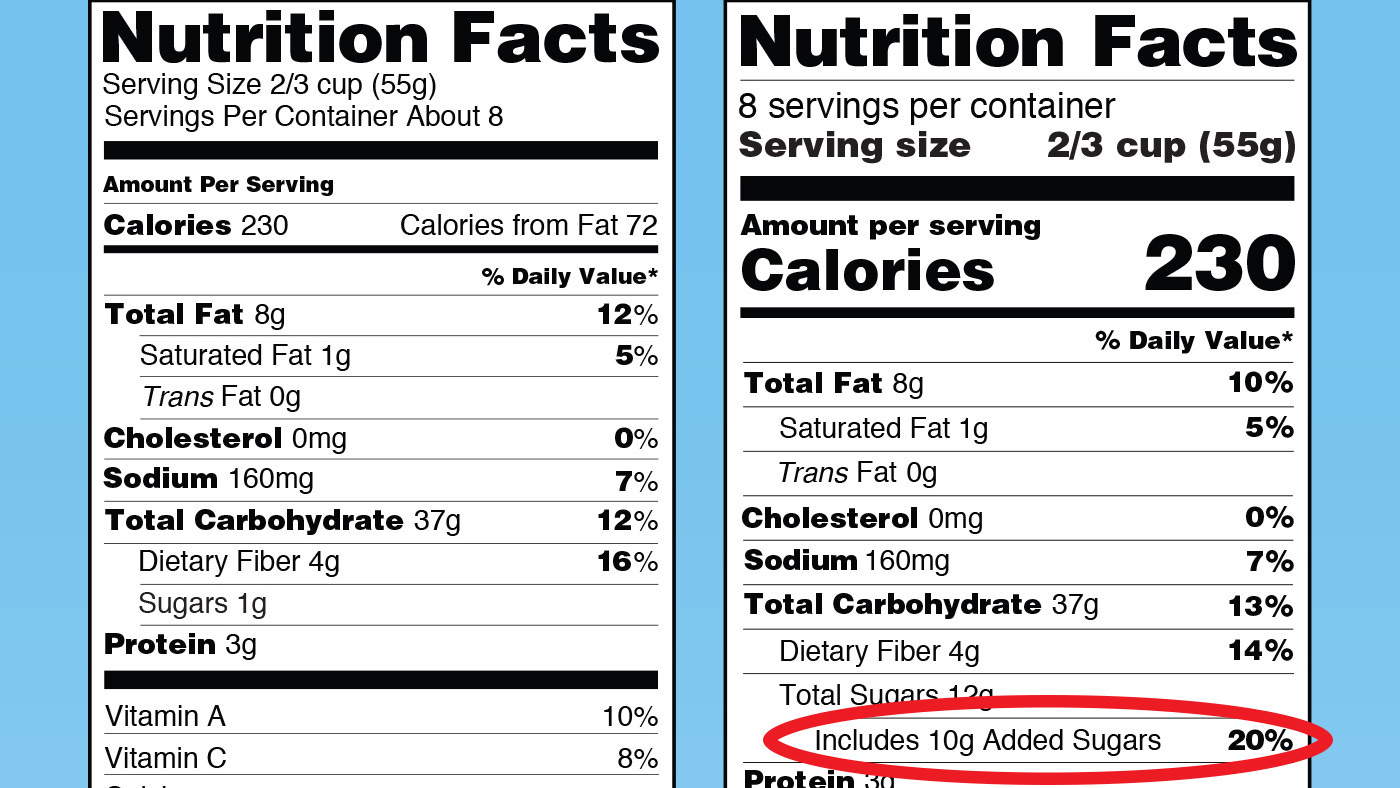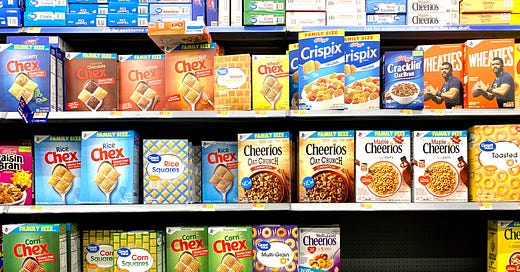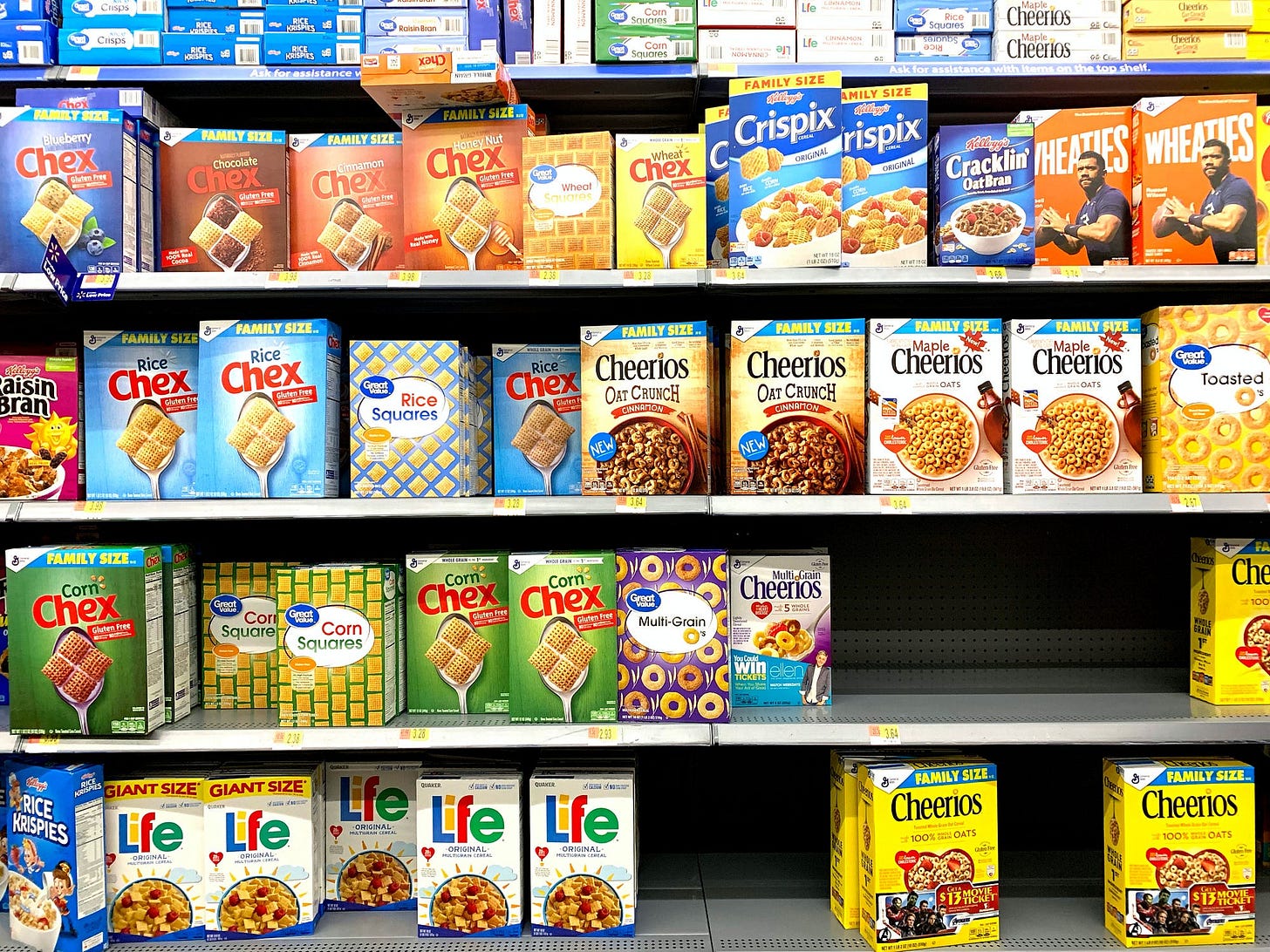Today we’re covering cereal and how to make it healthier.
You’ll learn: How you should think about sugar in different foods, why cereal may not be as unhealthy as you think, guidelines for which cereals are delicious but decently healthy, and how to consume cereal strategically around exercise.
Quick Housekeeping
Hello to all of you here after taking the Five-Day 2% Challenge.
This post, like all posts on Mondays, is free. Premium posts go out Wednesday and Friday and are for Members only. Become a Member below.
Wednesday we'll cover how a change to the food system in the 1920s still helps us today (even though some people think it doesn't).
Friday will be our Q&A. Email me if you have any burning questions you’d like me to investigate and answer.
Remember you can get free months of premium access to 2% and training programs by sharing 2%.

Note from Michael: Today’s post was written by Sabrina Daswick. I first met Sabrina when we overlapped briefly while I was an editor at Men’s Health. She now helps behind the scenes at 2%.
The idea for this post started thanks to a semi-embarrassing moment. My wife caught me standing in the pantry eating from her industrial-sized box of Cinnamon Toast Crunch.
“You’re just standing in the pantry … eating my cereal?” she asked. Why yes, that was exactly what was happening.
Cereal is one of my favorite foods. Definitely on the list if I had to pick five desert island foods. And it seems I’m not entirely alone.
Roughly 280 million Americans eat breakfast cereals. The breakfast cereal market will be worth more than $50 billion annually by 2030. Cereal-based restaurants are a thing.
I’m not under any delusions that, say, Cinnamon Toast Crunch is good for me. I treat all cereals like a dessert. But surely not all cereal can be bad for us. Grains, after all, allowed civilizations to rise.
And so I wondered: What makes a healthy-ish (or at least not disastrous) breakfast cereal? Is there a framework? And do any of those healthy-ish breakfast cereals taste like anything besides cardboard?
I wanted to write about the topic. But, dear reader, I am assuredly not the 2% team member to cover this topic. Sabrina is. She’s something of a cereal obsessive (she even has a TikTok account for cereal reviews).
So I asked Sabrina to go down that rabbit hole, where she seemingly already owns some real estate. Here’s Sabrina …
//
Growing up, you were one of two kids:
Kid A: You were the luckiest kid on earth, according to your 10-year-old friends. Your pantry shelf was lined with bright, cartoon-plastered cereal boxes. Froot Loops, Reese’s Puffs, Cap’n Crunch, and Lucky Charms were staples in your home.
Kid B: Your parents thought Cream of Wheat was cereal. You were the kid who couldn’t wait to go to Kid A’s house after school to eat mountainous bowlfuls of sugary cereal. No milk was wasted.
(Tell us which kid you were in the comments.)
I was Kid B. It wasn’t until high school, when my stay-at-home mom went back to work, that I could finally sneak in the good stuff. Breakfast became a bowl (or two) of Honey Bunches of Oats (🐐).
My juvenile taste buds followed me to college. I’d eat Frosted Flakes as a midnight snack, like a cereal-obsessed weirdo.
But every party has a pooper; in 2013, it was the anti-sugar movement.
Bookstores overflowed with variations of the “21-Day Sugar Detox.” Even the “For Dummies” franchise joined in and published “Beating Sugar Addiction For Dummies.” So I ended things with Tony the Tiger and pivoted to grown-up cereals that looked a lot like rabbit food (facts: Fiber One happened). Kid B was back.
And yet … since Kellogg's acquired Kashi in 2000, “health smart” cereal has steadily risen. And it’s led to fewer rabbit-food-like healthy cereals.
We now have low-sugar, keto, high-protein, high-fiber, grain-free, gluten-free, organic, etc. There’s even a new cereal that claims to help people sleep better. These choices vary in taste, price, and nutrients (more on Wednesday).
But ultimately, these cereals sell a vision of health that we may not need to buy into.
Because here’s the thing: Not everything in the Kid A pantry is likely as bad as you think. Well, sort of.
How sugary is cereal?
In short
Breakfast cereal is a small contributor to overall added sugar consumption. If you’re going to eat something sweet, you could do worse than cereal.
The details
In 1863, a guy named James Caleb Jackson invented the first cereal out of graham flour and called it “Granula,” which probably tasted how it sounds. Granula was so hard it had to soak overnight. Not unlike current-day Grape Nuts.
Then the iconic John Harvey Kellogg made his own version of Granula and called it “Granola” to avoid a lawsuit. Later he invented a new cereal called Corn Flakes, this time with some added sugar to make it more palatable.
Cold cereal took off—until it hit a speed bump in the 90s. Fad diets and health education became more mainstream, and people demonized cereal for being nothing but a sugar bomb. Cereal’s been trying to reinvent its image ever since.
To understand the severity of the sugar claims, I called Dr. Chris Mohr, PhD, RD, a nutrition expert who has consulted for and coached clients from the Cincinnati Bengals to Underarmour. He’s on the Men’s Health Magazine Nutritional Advisory Board and has presented to the White House and the CIA.
He also, like most normal humans, enjoys the occasional bowl of cereal.
“When my brother and I go to my parents, we eat Grape Nuts. We won’t use a bowl. We’ll put a mouthful of grape nuts in our mouth with a handful of raisins and pour the milk right in our mouth so we don’t have to clean a bowl.”
How to read sugar on a cereal label
First, Mohr explained that to evaluate a food’s sugar content, we should look at added sugar instead of total sugar.
Added sugar is added to the food, rather than naturally-occurring. Many generally healthy foods have naturally occurring sugar—milk, fruit, vegetables, etc.

“Something like Raisin Bran is going to be pretty high in sugar because raisins have naturally occurring sugar,” Mohr says.
Mohr called out the graphic below, pulled from USDA research. It shows that Americans’ added sugar intake comes primarily from beverages like soft drinks, followed by desserts, coffee, and candy. Cereal and sandwiches tie for fifth place. (Sandwiches?)
“The truth is, cereal is actually pretty low on the overall sugar intake for Americans in terms of where the top sources of sugar are coming from,” Mohr told me.
A cup of Cookie Crisp, Reese’s Puffs, or Lucky Charms has 12 grams of added sugar. Which: Not great! But also: Comparatively not the worst?
Added sugar quantities of common foods
Small Dunkin’ Donuts frozen coffee: 89 grams of added sugar
1 cup of Bush’s Original Baked Beans: 23 grams of added sugar
MetRX Protein Bar: 20 to 27 grams of added sugar
1 Energy Clif Bar, crunchy peanut butter: 18 grams of added sugar
Barbeque Sauce (1 tbsp): 16 grams added sugar (lol, who has one tablespoon?)
Clif Builder Protein Bar: 16 grams of added sugar
Small (tall?) Starbucks Blonde Vanilla Latte: 14 grams of added sugar
Rise Protein Bar: 13 grams of added sugar
Kombucha: 10 to 16 grams of added sugar
One serving of strawberry Chobani Greek yogurt: 9 grams of added sugar
1 packet of Quaker Oats Apples & Cinnamon Instant Oats: 8 grams of added sugar
1 Kind bar: 4 grams of added sugar
2 tablespoons of Wish-Bone Garlic Basil Italian Salad Dressing: 2 grams of added sugar
Relatively speaking, cereal isn’t quite the sugar demon everyone says it is. I.e., people will avoid cereal “cuz sugar” then slather chicken in a few servings of barbecue sauce, giving them 25 grams of protein—and 48 grams of added sugar, or the equivalent of 4 bowls of Lucky Charms.
Cereal is no vegetable omelet—for sure—but given its deliciousness to sugar content ratio, it’s not the worst thing a person could eat.
Your move
The point is to become aware of your added sugar content across the board—so you can decide how much sugar you’d like to eat and in what form.
To be clear, no one *needs* added sugar. But let’s not get all puritanical here. No one *needs* added fat, either. Living well is a question on responsibly balancing the delicious foods we’re surrounded by.
How Much Sugar is Too Much?
In short
The less active you are, the less added sugar you should eat. The more active you are, the more added sugar you can get away with.
The details
We know too much added sugar in your diet contributes to obesity, type 2 diabetes, and heart disease, to start.
This is perhaps the one thing that US Government Researchers and the “Everything the Government Says is Wrong” nutrition pundits of Podkastistan agree on.
The American Heart Association recommends the average American should eat no more than:
Adult men: 36 grams
Adult women: 25 grams
Children: 24 grams
These aren’t hard and fast rules because your activity level will alter the impact any given daily amount of sugar has on you (sort of like how we learned last week that people can get away with different levels of salt intake dependent on their activity level and medical background.) And to be clear, the AHA is trying to be reasonable with their recommendation—they’d prefer the average American have none, but telling people to eat none is useless information.
When it comes to sugar—like all things—the dose makes the poison. And how you buffer poison depends on your lifestyle.
For example, a person getting 3,000 steps a day might want to cut added sugar entirely. An ultramarathoner can get away with (and may even benefit from) eating 36 grams of sugar at breakfast, lunch, and dinner.
As 2% advisor Dr. Trevor Kashey said in his recent podcast episode, “Sugar toxicity seems to be more like couch toxicity.”
Cereal as workout fuel
If you’re active and enjoy cereal, managing your added sugar intake is key. You may even use it as training fuel.
Simple carbohydrates like sugar bypass digestion and are, therefore, easier on your stomach during endurance training than complex carbohydrates, such as vegetables or oatmeal.
That’s why cereal is a pre-workout hack for many endurance athletes. Otherwise, they risk depleting the glycogen stores in their body and becoming sluggish.
For example, the greatest ultrarunner on the planet, Courtney Duawalter, regularly eats kids cereal. She recently told Runner’s World:
A general training day would start with two cups of coffee with a French vanilla creamer, and some handfuls of dry cereal—usually just straight out of the box. My go-tos are all the sugar cereals, and right now, that means Cinnamon Toast Crunch. And then I usually get going with my training.
The Cereal Guidelines and Ranking
In short
Finding a good cereal with less than 10 grams of cereal strikes a nice balance between taste and not being too bad for you.
The details
Mohr’s general rule of thumb is to choose a cereal with less than 10 grams of added sugar per serving. I’ve been taste-testing cereals for the past few years for my cereal accounts. Here’s a rundown of my favorites that fall under Mohr’s recommendations.
The top cereals with less than 10g of added sugar per serving:
Honey Bunches of Oats, 8g
Life, 9g
Cheerios, 1g (!)
Kashi Honey Toasted, 7g
Great Grains Raisins, Dates & Pecans, 4g
Quaker Oatmeal Squares, 9g
Honey Nut Chex, 9g
Kashi GO Peanut Butter Crunch, 9g
Special K Original, 4g
Cheerios, 1g
Kashi Cinnamon Harvest, 9g
Total, 5g
If you think all of those suck, here are three options:
Mix a bit of your favorite cereal in with a lower-sugar cereal. For example, a quarter serving of Reese’s Puffs mixed with Rice Chex, which has just 3 grams added sugar. That reduces the added sugar load per serving.
Dump a bit of your favorite no-calorie sweetener—like Stevia or Splenda—onto a lower-sugar cereal, like Cheerios.
Add fresh fruit to an otherwise boring cereal. For example, sliced banana takes Cheerios to the next level.
What about Keto/Zero-Sugar Cereals?
In short
Keto cereals are expensive and yucky.
The details
If you like keto-style cereals, we can still be friends. And I understand that some people have legitimate health concerns that require a keto diet.
Keto cereals are:
Low-carb (~15 grams)
Low-sugar (0-3 grams
High-protein (8-13 grams)
Not typically fortified with added vitamins and minerals (we’ll talk about the upsides of fortification on Wednesday)
Magic Spoon, a $10 keto cereal targeting adults, is crushing sales. Three Wishes, another popular keto brand, is $6.99 at Target.
I find the cost and taste hard to swallow, but some people don’t. Live your life!
If you want a non-keto option that helps you hit your protein for the day, Special K makes two high-protein cereals.
The cinnamon version has 10 grams of protein per serving and the chocolate almond one has 20 grams. It’s pricey — $8.28 at Target — but the box is hefty and filled past the halfway mark (rare in cereal world).
Both check the “under 10 grams of added sugar” box and have a solid amount of nutrients like iron, folate, and zinc. These cereals are certainly more edible than Magic Spoon, although they’re definitely no Cinnamon Toast Crunch.
A note on “high-protein”
One thing to look for in any food labeled “high protein”: The ratio of calories to sugar. For example:
Let’s say Food A is labeled “high-protein,” and it has 10 grams of protein and 230 calories per serving.
Food B has 5 grams of protein and 100 calories per serving.
This means that Food B, despite not getting the “high-protein” designation, is actually higher in protein. An equivalent caloric amount of that cereal has more protein per calorie.
And here’s Michael again, with a final note: Props to Sabrina for all the work. And we hope you didn’t take this post to mean, “Please go pound sugary cereal.”
Rather, we hope you learned that cereal may not be as unhealthy as you might think, that it’s OK for all but the most sedentary to enjoy in moderation, and that some cereals may be healthier or “less bad,” than others.
Have fun, don’t die—and enjoy cereal.
-Michael
Sponsored by Momentous
Momentous made me feel good about supplements again. Over 150 professional and collegiate sports teams and the US Military trust their products, thanks to the company’s rigorous science and testing. I don’t have the time or desire to cook perfectly balanced meals that give me all the necessary nutrients and protein I need (let’s face it, few of us do!). So I use their collagen in the morning; Recovery protein during hard workouts; essential multivitamin to cover my bases; creatine because it’s associated with all sorts of great things; and Fuel on my longest endurance workouts on 100+ degree days here in the desert (because Rule 2: Don’t die). And I also love (love!) that Momentous is researching and developing women-specific performance supplements. Use discount code EASTER for 15% off.
Sponsored by GORUCK
When I decided to accept sponsorships for this newsletter, GORUCK was a natural fit. Not only is the company's story included in The Comfort Crisis, but I've been using GORUCK's gear since the brand was founded. Seriously. They've been around ~12 years and I still regularly use a pack of theirs that is 11 years old. Their gear is made in the USA by former Special Forces soldiers. They make my favorite rucking setup: A Rucker 4.0 and Ruck Plate. Use discount code EASTER8 for 10% off anything from GORUCK.
Sponsored by Maui Nui Venison
Axis Deer provides the healthiest meat on the planet. That's according to researchers at Utah State, who compared axis deer meat to beef and found that it contains 1 to 64 times more antioxidants, vitamins, minerals, and healthy fats. It also contains 53% more protein per calorie than beef. Here's a fascinating brief on the research. Equally important is that Maui Nui solves ethical considerations around meat. Axis Deer are an invasive species ravaging the Hawaiian island of Maui, and Maui Nui harvests the deer at night in a stress-free way, improving the ecosystem.
My picks: I like it and eat everything from Maui Nui, but the 90/10 Organ Blend is particularly great for people looking to get more micronutrients in their diet, and the Jerky Sticks are my go-to travel snack. Use discount code EASTER for 15% off.






FWIW, I was Kid B. 'Cuz sugar.
But the strangest part about my Kid B upbringing is that my mother had zero qualms with me drinking gallons of Hawaiian Punch, which, to my knowledge, is liquid sugar dyed red. Lol.
My favorite cereal is Reese's Puffs. I mix a bit of it into healthier cereals.
I was a mix of kid A and B. When we switched to boring cereals, I took the Calvin (of Calvin and Hobbes) route and doused bowls of Chex in sugar and ate the slurry at the bottom of the bowl. Not my finest years.